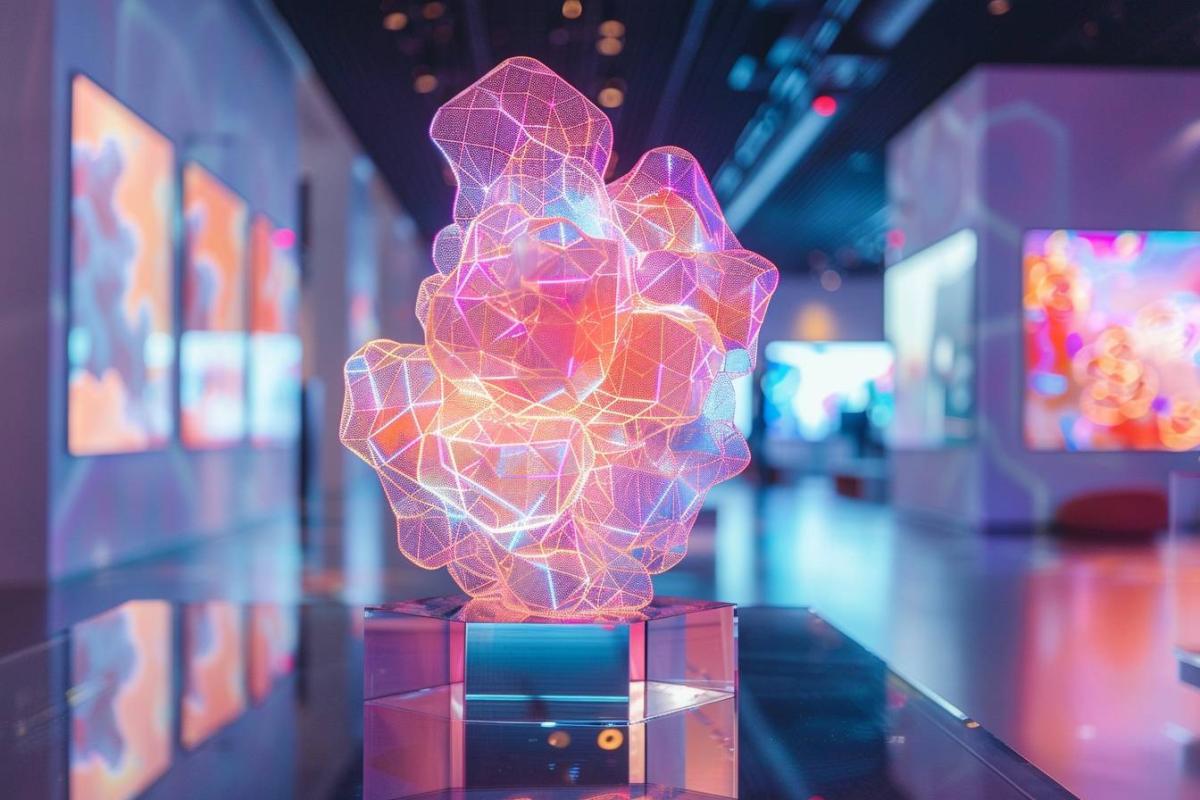The art world is experiencing a real revolution with the emergence of NFTs. These unique digital tokens are shaking up traditional codes and dividing opinion. Let’s dive into this captivating world to understand whether NFTs are a simple speculative bubble or a true artistic revolution.
Sommaire
The meteoric rise of NFTs in the art market
NFTs, or “Non-Fungible Tokens”, have experienced a meteoric rise in recent years. As a curious writer always on the lookout for new topics, I have been fascinated by the spectacular evolution of this market. From $210 million in 2019, it reached the impressive figure of $40 billion in 2021.This exponential growth testifies to the unprecedented craze for this new form of digital art.
The entry on the scene of prestigious auction houses like Christie’s and Sotheby’s has given undeniable legitimacy to the phenomenon. The most striking example is undoubtedly the record sale of the work “Everydays: The First 5000 Days” by the artist Beeple. Sold for the astronomical sum of $69.3 million at Christie’s in 2021, this sale marked a turning point in the history of digital art.NFTs offer new opportunities for digital artists to monetize their creations. In particular, they allow them to collect royalties on resales, a significant advantage in a traditionally opaque market. This increased transparency on the ownership and transactions of works is one of the strong arguments in favor of NFTs.
Artistic revolution or speculative bubble?
The question that arises is whether NFTs represent a true artistic revolution or whether they are just a speculative bubble destined to burst. On the one hand, we cannot deny the positive impact on the democratization of digital art. New artists are emerging thanks to this more accessible market, while new types of collectors are appearing.
On the other hand, the phenomenon also raises legitimate questions about the real artistic value of certain NFTs. “Cryptopunks” and other NFT collections are sometimes traded at dizzying prices, raising doubts about the sustainability of these investments. Here is a summary table of the arguments for and against NFTs in the art world:
For
| Against | Democratization of digital art |
|---|---|
| Excessive speculation | New opportunities for artists |
| Artistic quality sometimes questionable | Transparency of transactions |
| Fraud and plagiarism issues | Authenticity guaranteed by the blockchain |
| Environmental impact of blockchains | It is imperative to note that the NFT market is part of a broader trend of digitalization and decentralization of the art market. This development raises legal and ethical questions which remain to be resolved, particularly in matters of copyright and intellectual property. |
NFTs: speculative bubble or artistic revolution?
Despite the enthusiasm generated by NFTs, several challenges persist and must be addressed to ensure the sustainability of this new form of artistic expression. As a modern web editor, I strive to popularize these complex issues to make them accessible to everyone.
Among the main challenges, we can cite:
There
- market regulation : the legislation around NFTs remains unclear and needs to be clarified to protect both artists and buyers. There
- fight against fraud and plagiarism : mechanisms must be put in place to guarantee the authenticity of works and prevent abuse. There
- reduction of environmental impact : Blockchains consume a lot of energy, a problem that must be addressed for sustainable adoption of NFTs. L’
- public education: It is vital to educate potential buyers about the risks and opportunities associated with NFTs. Despite these challenges, the future prospects of NFTs in the art world appear promising. Blockchain technology offers new possibilities in terms of traceability and authentication of works. In addition, it opens the way to new forms of creation and interaction between artists and collectors.
It is fundamental to note that the craze for NFTs is part of a broader context of growing interest in
promising cryptocurrencies . Artists and collectors interested in NFTs are often also attracted to the world of cryptocurrencies, creating a growing digital ecosystem.In short, NFTs undeniably represent a major innovation in the art world. Whether it is a lasting revolution or a speculative bubble, their impact on artistic creation and the art market is already significant. The future will tell us whether this technology will manage to overcome its challenges and establish itself as a new paradigm in the history of art.


